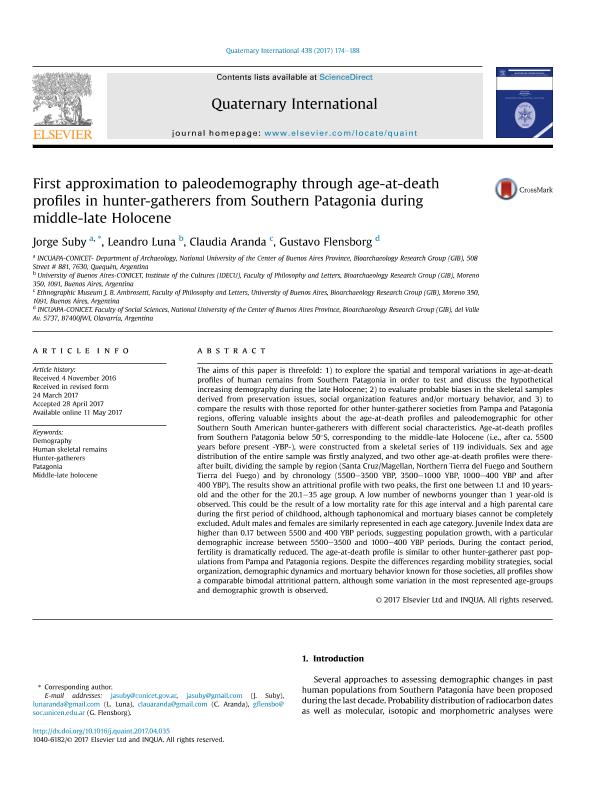Mostrar el registro sencillo del ítem
dc.contributor.author
Suby, Jorge Alejandro

dc.contributor.author
Luna, Leandro Hernan

dc.contributor.author
Aranda, Claudia Marcela

dc.contributor.author
Flensborg, Gustavo Ariel

dc.date.available
2018-03-20T15:56:52Z
dc.date.issued
2017-05
dc.identifier.citation
Suby, Jorge Alejandro; Luna, Leandro Hernan; Aranda, Claudia Marcela; Flensborg, Gustavo Ariel; First approximation to paleodemography through age-at-death profiles in hunter-gatherers from Southern Patagonia during middle-late Holocene; Pergamon-Elsevier Science Ltd; Quaternary International; 438; 5-2017; 174-188
dc.identifier.issn
1040-6182
dc.identifier.uri
http://hdl.handle.net/11336/39343
dc.description.abstract
The aims of this paper is threefold: 1) to explore the spatial and temporal variations in age-at-death profiles of human remains from Southern Patagonia in order to test and discuss the hypothetical increasing demography during the late Holocene; 2) to evaluate probable biases in the skeletal samples derived from preservation issues, social organization features and/or mortuary behavior, and 3) to compare the results with those reported for other hunter-gatherer societies from Pampa and Patagonia regions, offering valuable insights about the age-at-death profiles and paleodemographic for other Southern South American hunter-gatherers with different social characteristics. Age-at-death profiles from Southern Patagonia below 50°S, corresponding to the middle-late Holocene (i.e., after ca. 5500 years before present -YBP-), were constructed from a skeletal series of 119 individuals. Sex and age distribution of the entire sample was firstly analyzed, and two other age-at-death profiles were thereafter built, dividing the sample by region (Santa Cruz/Magellan, Northern Tierra del Fuego and Southern Tierra del Fuego) and by chronology (5500–3500 YBP, 3500–1000 YBP, 1000–400 YBP and after 400 YBP). The results show an attritional profile with two peaks, the first one between 1.1 and 10 years-old and the other for the 20.1–35 age group. A low number of newborns younger than 1 year-old is observed. This could be the result of a low mortality rate for this age interval and a high parental care during the first period of childhood, although taphonomical and mortuary biases cannot be completely excluded. Adult males and females are similarly represented in each age category. Juvenile Index data are higher than 0.17 between 5500 and 400 YBP periods, suggesting population growth, with a particular demographic increase between 5500–3500 and 1000–400 YBP periods. During the contact period, fertility is dramatically reduced. The age-at-death profile is similar to other hunter-gatherer past populations from Pampa and Patagonia regions. Despite the differences regarding mobility strategies, social organization, demographic dynamics and mortuary behavior known for those societies, all profiles show a comparable bimodal attritional pattern, although some variation in the most represented age-groups and demographic growth is observed.
dc.format
application/pdf
dc.language.iso
eng
dc.publisher
Pergamon-Elsevier Science Ltd

dc.rights
info:eu-repo/semantics/openAccess
dc.rights.uri
https://creativecommons.org/licenses/by-nc-sa/2.5/ar/
dc.subject
Demography
dc.subject
Human Skeletal Remains
dc.subject
Hunter-Gatherers
dc.subject
Middle-Late Holocene
dc.subject
Patagonia
dc.subject.classification
Historia

dc.subject.classification
Historia y Arqueología

dc.subject.classification
HUMANIDADES

dc.title
First approximation to paleodemography through age-at-death profiles in hunter-gatherers from Southern Patagonia during middle-late Holocene
dc.type
info:eu-repo/semantics/article
dc.type
info:ar-repo/semantics/artículo
dc.type
info:eu-repo/semantics/publishedVersion
dc.date.updated
2018-03-12T19:32:34Z
dc.journal.volume
438
dc.journal.pagination
174-188
dc.journal.pais
Estados Unidos

dc.journal.ciudad
Amsterdam
dc.description.fil
Fil: Suby, Jorge Alejandro. Consejo Nacional de Investigaciones Científicas y Técnicas. Centro Científico Tecnológico Conicet - Tandil. Investigaciones Arqueológicas y Paleontológicas del Cuaternario Pampeano. Universidad Nacional del Centro de la Provincia de Buenos Aires. Investigaciones Arqueológicas y Paleontológicas del Cuaternario Pampeano; Argentina
dc.description.fil
Fil: Luna, Leandro Hernan. Consejo Nacional de Investigaciones Científicas y Técnicas. Oficina de Coordinación Administrativa Saavedra 15. Instituto de Las Culturas. Universidad de Buenos Aires. Instituto de Las Culturas; Argentina
dc.description.fil
Fil: Aranda, Claudia Marcela. Universidad de Buenos Aires. Facultad de Filosofía y Letras. Museo Etnográfico "Juan B. Ambrosetti"; Argentina
dc.description.fil
Fil: Flensborg, Gustavo Ariel. Consejo Nacional de Investigaciones Científicas y Técnicas. Centro Científico Tecnológico Conicet - Tandil. Investigaciones Arqueológicas y Paleontológicas del Cuaternario Pampeano. Universidad Nacional del Centro de la Provincia de Buenos Aires. Investigaciones Arqueológicas y Paleontológicas del Cuaternario Pampeano; Argentina
dc.journal.title
Quaternary International

dc.relation.alternativeid
info:eu-repo/semantics/altIdentifier/doi/http://dx.doi.org/10.1016/j.quaint.2017.04.035
dc.relation.alternativeid
info:eu-repo/semantics/altIdentifier/url/https://www.sciencedirect.com/science/article/pii/S1040618216313556
Archivos asociados
